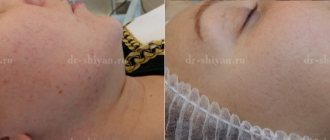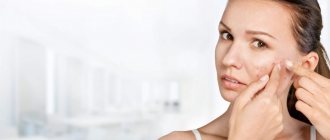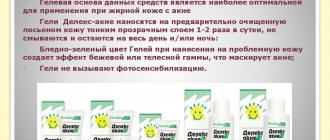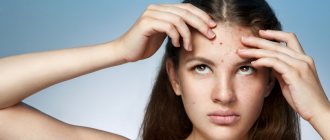Modern trends to look decent in society often run counter to maintaining health. Starting from adolescence, 95% of girls try to get rid of the hated rash. Pimples are ripped off with fingernails, pierced with needles - there are many ways to make fun of your face without thinking about the consequences at all. If you conduct a survey “why do pimples crush?”, the answer will be the same: it’s ugly. Meanwhile, an activity that seems innocent at first glance can even lead to death if the rash is located in a certain location. It is necessary to convey information to children (and adults) as often as possible to consider whether to squeeze pimples or get rid of them using safe methods. Facial care should be competent and safe!
Dermatillomania: causes
Dermatologists note that this problem is more common in people diagnosed with acne. In this case, picking at the skin may be associated with complexes and the desire to quickly get rid of the hated rashes. Unfortunately, it only gets worse.
Not the least role in this is played by filters, Photoshop, Instagram masks, which create in people a false idea of ideal skin not as healthy, but as completely smooth, devoid of any flaws, irregularities and not subject to age-related changes.
Some experts consider neurotic excoriation to be a type of obsessive-compulsive disorder. Others suggest distinguishing them according to this principle:
- if scratching the skin is a way to relieve anxiety, then it can be classified as an obsessive-compulsive behavior;
- if the action is associated with the very need to scratch the skin, then this should be considered dermatillomania.
Despite the fact that a person may be fully aware of the harm he is causing to himself, he cannot stop. Many compare the state to a trance.
There is also a hereditary connection. In addition to genetic predisposition, depression, eating disorder, dysmorphophobia, psychological trauma, chronic stress or other forms of addiction can provoke uncontrolled skin trauma.
Types of acne
Acne, or acne, is an inflammatory disease of the skin appendages (sweat and sebaceous glands, hair follicles). This problem is in 1st place in prevalence among all skin diseases, since the glands begin to actively function in newborns, and stop working in old age.
In women, this problem occurs more often, but at 10-12 years of age, the rash occurs with approximately the same frequency in boys and girls. The overwhelming majority of pathology is genetically determined: a certain set of genes responsible for the quality, quantity and structure of the sebaceous glands and their sensitivity to external and internal influences is inherited from parents.
Depending on the depth of skin damage and the presence of inflammation, the main types of acne are distinguished:
- "Whitehead" (milium): pimples in the form of grains of rice. The rash element is located in the upper layer of the skin; it is a dense cyst of the sebaceous gland. The nodule is painless, up to 3 mm in size.
- “Blackhead” (open comedon): the well-known blackheads. Sebum, dust, and cosmetic residues accumulate in enlarged pores. Ferrous secretions are initially white, but when exposed to air they oxidize and darken.
- White (closed) comedones are the same as black ones, but before oxidation. Due to the blockage of the pore with a thin layer of the epidermis, its contents accumulate inside, and a protrusion is formed - a tubercle, which can be determined by touch. The color of the seal does not differ from the surrounding skin or may be lighter than it.
- Papule: its predecessor is a closed comedon. The secretion of the glands accumulates in the pore and does not find a way out, and inflammatory cells delimit it from the surrounding skin. A dense nodule of 1-3 mm is formed, which can become inflamed due to injury (one of the reasons why you should not squeeze pimples).
- Abscess: inflamed nodule. The glandular secretion suppurates, and an inflammatory “ridge”—redness—forms around it. Pus is visible in the center of the pimple; may result in severe pain.
Dermatillomania: symptoms
In itself, squeezing pimples* is not a sign of a mental disorder. Although it’s still not worth doing this. The symptoms here are similar to addiction. The person cannot stop, then there is a short period of relief, followed by guilt, discomfort and the cycle starts again.
You should be wary if31:
- it interferes with daily activities;
- makes you avoid social contacts;
- you have to wear closed clothes to cover scars or fresh marks;
- pimples*, crusts or any other formations on the skin are perceived as something foreign and incorrect, which should be gotten rid of immediately, regardless of the consequences;
- you have already made repeated attempts to stop, but in vain.
Most often, the pathology occurs in girls 16-24 years old.31
"Triangle of Death" and acne
Experts do not recommend squeezing out acne on your own, and if they are located in the nasolabial area, they warn about the mortal danger of such an action.
During inflammation, the blood vessels in the affected area dilate. This is required so that leukocytes quickly reach the inflamed area. When squeezing out an acne element, we exert a mechanical force on it, risking damage to the walls of nearby vessels. Such actions are a direct path to infection. It quickly spreads, heading to the sinuses and meninges. When the latter become inflamed, meningitis develops, and when infection enters the sinuses, blood clots may appear. The formation of blood clots is explained by the fact that blood coagulates around particles from the inflamed lesion, and the neoplasm increases to such a size that it clogs the vessel.
The danger is that the venous sinuses supply the brain with blood. In the area of the nasolabial triangle there is a dense network of blood supply, so the soft tissues of the face heal relatively quickly. There are many veins, arteries, and anastomoses in this area. Veins form two networks – deep and superficial. One of the most important veins, the facial vein, is connected to the deep pterygoid venous plexus and also flows into the jugular vein, which leaves the cranial cavity and descends to the neck.
The facial vein is often involved in the process of inflammation during suppuration on the wings of the nose and upper lip. Under normal conditions, the direction of outflow of venous blood is from top to bottom to the jugular vein. But if blood clots form inside the facial vein and its tributaries, retrograde (reverse) blood flow occurs, which leads to inflammation of the sinuses and meningitis. They cannot always be diagnosed immediately, which aggravates the problem and sometimes leads to irreversible consequences.
Dermatillomania: treatment
The main questions for dermatillomania are: which doctor to see, how to deal with the obsessive desire to squeeze pimples* and how to get rid of the consequences of such actions in the form of scars.
As with any addiction, the main thing is to admit that there is a problem. Next, you should work with a psychologist. Cognitive behavioral therapy has proven itself well. Medications are prescribed as a last resort. More often they are necessary if the disorder is accompanied by other mental illnesses.
It is also worth contacting a dermatologist. He will select medications (topical or systemic) for rashes and care products for problem skin.
One of the drugs used for mild to moderate acne is Azelik® gel. It should be applied 2 times a day to clean, dry skin.5
Cosmetic procedures will help improve the condition of the skin and remove scars.
Reasons for lack of results in acne treatment:
Home care is also often a problem. There are options when home care is not adjusted at all, and the patient continues to torture his skin with all available and advertised products, or there is no care at all. Of these two evils, lack of care is perhaps the best option. One common mistake is hoping to get rid of acne only with the help of a treatment, such as a medicated cream.
cosmetologist Yuliana Shiyan
Comment from a cosmetologist:I often hear during consultations: “I tried this cream, it didn’t help me . It is obvious that the patient has unrealistic hopes for the cream. Therapeutic home care, of course, will contribute to cleansing the skin, but this is an auxiliary element, and not the basis of treatment. Just like procedures, they are a vital element in treatment, but in themselves they provide only a short-term effect. Everything should be in moderation and in totality.
Constant change of doctors during treatment
I have been working with problem skin for many years and I can certainly say that this is one of the most common reasons. Sometimes there is a need to change a doctor when there are doubts about the doctor’s competence. And more often, the patient goes from doctor to doctor because no one prescribes a magic pill and after a couple of cleanings for some reason there is no result or drugs are prescribed that the patient is afraid to take. And every time, the next dermatologist (cosmetologist) starts from scratch. As a result, the result is zero, invaluable time wasted, and as a result, complete disappointment!
Fear of taking prescribed treatment for acne
Acne. What to do?
Before a patient sees a doctor, he studies “a lot of things” on the Internet. The patient is infested with myths and negativity regarding combined oral contraceptives and retinoids, which are often the mainstay in the treatment of acne. And not just a basis, but irreplaceable drugs in most cases.
Practice shows that those who put off this treatment for years still decide on it in the end. And on top of years of torment from acne, you get severe scars and blemishes on your tormented skin, and of course, several courses of laser resurfacing to get rid of them.
You need to know that the doctor always prescribes treatment in proportion to the severity of the disease. If the cause of acne is a hormonal imbalance, you cannot do without COCs. If the acne is severe, then you can apply creams to your face and cleanse your intestines as much as you like; only retinoids will save you.
Amateur performance
Discontinue medications at the first signs of skin clearing. A good result is very relaxing. Quickly forgotten:
- that the ointment is prescribed for 6 months, not 3 months
- that the procedure is mandatory at each stage
- that you don’t need to take the first cream you see off the shelf
- that the New Year's table is for beloved relatives, but not for beloved skin
- “Cumulative dose of retinoids? What is this? Doctor, you probably just forgot to tell me..."
We completed the treatment and with a clear conscience returned to our previous diet and prohibited skin care (for example, oils or creams based on them). Many patients are convinced that high-quality skin treatment is a guarantee of the absence of acne in the future. And no matter how sad it is to talk about it, such conviction is often the fault of the attending physician.
Why? Because he didn't spend enough time explaining that acne susceptibility doesn't go away, even if your face clears up. After the main treatment, supportive, powerful home care is still prescribed for some time, continuing to work with the causes of acne, if it is nutrition and/or internal diseases.
Pustules on the face: what to do?
Since pustules indicate an inflammatory process, most cosmetic procedures are contraindicated for them. What remains is drug treatment and home care. Here are some guidelines to follow:
- Gentle care. If there are an abundance of pustules, it is necessary to take more careful care of the skin so as not to damage them. It is necessary to discard the idea of squeezing out acne elements. This is fraught with the spread of inflammation and aggravation of the clinical picture.
- Exclusion of alcohol-containing products from care. Attempting to dry acne will not be beneficial. The skin will respond with even greater sebum production and hyperkeratinization. And these are already two links in the mechanism of acne formation.
- Nutrition correction. Since the appearance of acne may be associated with the consumption of certain products, for example, dairy. There is evidence that if there is an excess of sugar and fat in the diet, as well as eating on the go, it can provoke an exacerbation of acne.60
- Light makeup. Pustular rashes are very difficult to hide with cosmetics. As a rule, applying a generous amount of foundation creates a mask effect. The face looks unnatural and the skin cannot breathe. As a result, the pores only become more clogged. Makeup for acne is acceptable, but it is better to keep it light. In the evening, it must be carefully removed, for example, with micellar water or milk.
- Refusal of traditional methods of treatment. Do not try to prepare masks or creams yourself. Firstly, the use of multi-component compositions prepared by yourself can provoke irritation, itching, redness, and an allergic reaction. Secondly, you will waste time and may make the problem worse.
You can get rid of pustular rashes only by using medications prescribed by a dermatologist.
Why does pimple inflammation* occur on the face?
One of the links in the pathogenesis of acne is an increase in the colonization of propionibacteria. Their reproduction is promoted by anaerobic conditions (clogged pores). Propionibacterium acnes during its life processes secrete substances that can attract neutrophilic leukocytes involved in inflammation. The body defends itself by producing antibodies in response - antigens of propionibacteria, which support the inflammatory process.10
Due to microbial antigens, neutrophil granulocytes and mononuclear phagocytes, which are part of the physiological protective system of cells, are attracted to the location of the rash. This contributes to the development of aseptic inflammation.10
Clindovit gel is a topical antibiotic. Its main active ingredient is clindamycin. It exhibits antimicrobial activity against propionibacteria.6
But it has long been proven that inflammation during acne formation is primary. Irritation of sebocytes (cells of the sebaceous glands) leads to the production of interleukins, which in turn are stimulators of inflammatory reactions. They provoke follicular hyperkeratosis, cause blockage of the sebaceous glands, resulting in the formation of comedones.40
Next, leukocytes 10 are attracted to the walls of the follicle. The vessels located around the inflamed area dilate, which causes swelling and redness. During the process of inflammation, cell destruction occurs and a cavity forms inside the papule. Over time, it fills with pus (a product of the breakdown of leukocytes and bacteria), transforming into a pustule 29.
Subcutaneous acne: causes and symptoms
The causes of subcutaneous rashes may be as follows29,50,41:
- Endocrine disorders. The work of the sebaceous glands is influenced by androgens. When testosterone levels rise, they produce more sebum, which can lead to breakouts.
- Heredity. It has been proven that if parents have suffered from acne, there is a high probability that the child will also show symptoms of the disease. In addition, there is genetically determined hyperandrogenism, which causes an increased level of sebum production and affects the processes of keratinization.
- Skin injury. Any mechanical impact on the skin can lead to the formation of rashes. We are talking not only about squeezing out acne, but also about frequent and prolonged rubbing of clothing straps, the habit of resting your chin with your hand, etc.
- Nutritional factors. The role of nutrition in the formation of rashes is still controversial. But there is still an opinion that for acne it is better to exclude milk, fatty meats, desserts, spicy and hot dishes. It is better to stick to a low glycemic index diet.
- Use of cosmetics with comedogenic components. The comedogenicity of individual ingredients in a cosmetic product is highly individual. So, in one person it can provoke acne, but in another it may not cause any negative reaction.
- Taking medications. Glucocorticoids, anabolic steroids, anti-epileptic drugs, even some vitamins can cause rashes.
Another factor influencing the formation of acne is hygiene. By itself, it does not cause acne, but it can help create favorable conditions for bacteria to multiply, increase sebum production, and clog pores. Moreover, this applies to both insufficiently frequent cleansing of the skin and frequent washing.
You need to understand that subcutaneous acne needs treatment. It must be pathogenetic, that is, affecting the links of pathogenesis. Clindovit® gel is active against propionibacteria, which cause acne, and also reduces the level of free fatty acids on the skin surface.6
To effectively combat acne, it is necessary to find out the causes that caused the disease and begin treatment on time.
Symptoms of acne (acne)
- Increased oiliness of the skin of the face and head (increased sebum production);
- Small or large red rash;
- The appearance of white ulcers;
- Soreness of the skin in the areas of the rash;
- Scars and pigmentation after acne heals.
In the first stage, acne affects only certain areas of the face - most often the forehead, cheeks and chin. In the future, acne spreads to the neck and chest areas. At the third stage, ulcers and acne increase in size, covering increasingly large areas of the skin, and after healing they leave large scars.
Regular cleansing and skin care –
Wash your face twice a day with mild cleansers. For acne patients, cleansers usually contain salicylic acid or alpha hydroxy acids. Salicylic acid is lipophilic, and therefore will effectively help dissolve fat plugs, but this only applies to blackheads (open comedones). The exfoliating effect of salicylic acid is extremely insignificant, therefore, for so-called whiteheads, it is best to use washes with alpha hydroxy acids. The latter have a slightly more pronounced exfoliating effect.
In addition, you should give up comedogenic cosmetics, and also ensure that your cleansers remove not only ordinary water-soluble impurities, but also fat-soluble impurities (cosmetic residues). If you start using adapalene, then at first you should avoid scrubs (to prevent skin irritation).
A very important point - in spring and summer, regularly use sunscreen with SPF 50, because it will also help you prevent new acne from appearing. This is not only important if you are using topical products with topical retinoids or benzoyl peroxide. For example, solar radiation directly leads to the development of epidermal hyperkeratosis, which contributes to obstruction of the follicles (the formation of comedones in them). Sun cream must be non-comedogenic, preferably in the form of a suspension, as in the photo below. Next, we will tell you how mechanical acne removal is carried out.
Sunscreen with SPF 50 (our editor's choice):
Pustules are small pustules on the face
A pustule is an inflammatory acne element, inside of which there is a cavity filled with purulent contents. Its size can reach 10 mm. The shape can be cone-shaped, flat, hemispherical. A pustule can form as an independent element or from a papule. When pustules appear on the face, the cause must be sought in the inflammatory process occurring in the skin.
You can tell that a pustule has formed by looking at the white head of the pimple*. Its contents are usually white, yellowish, and sometimes greenish. The contents of the pustule may dry out, a crust will form on top of it, the fall of which may lead to the appearance of a hyperpigmentation spot.
If even small pustules appear on the face, it is necessary to take action, as they can turn into indurative acne. With this form of acne, inflammation spreads into the deeper layers of the skin. Resolution of such acneous elements may leave behind atrophic scars.32
Why can't you squeeze acne?
- Having squeezed out one pimple, wait for 5 more. The skin will turn red, the pus will not come out completely and the “bad pimple” will become inflamed 10 more times, and 5 more of the same will be added to it. You squeeze pimples in any convenient place, with dirty hands, with strong pressure - you can’t do that. The wound that forms on the face will be an excellent place to attract germs. The internal infection will spread throughout all the vessels, resulting in a whole acne attack.
- Scars, wounds, scars. The aesthetic condition of the face will suffer in an instant. There are people who, in nervous situations, begin to pick their faces wildly. One pimple takes more than a month to heal, and after it there remains a mark in the form of a spot. Therefore, you shouldn’t do this if you don’t want to earn new complexes and a dozen newbie acne.
What happens if you don't squeeze out a pimple, what does it look like?
It will be great! A pimple that is not squeezed out does not look very beautiful, but at least it will disappear quickly and will not cause 5 more of its “friends”. There are 2 types of acne: internal and external. Internal ones are dangerous, take longer to pass - it is strictly forbidden to touch them. Wait 3-5 days, it will definitely disappear. Spring ones, it is also not advisable to press. At first it is a small red dot, the next day or every other day pus appears. Wait another day, it will disappear on its own, dry up and fall off.
How many days does it take for acne to go away?
The question is common, but individual. On average, without touching a pimple, it will go away in 3 to 5 days, unless you have serious acne and this is an isolated case. But if hands reach out to it, then the wound can heal for a week, two, a month. Therefore, we strongly recommend not to crush acne, and in case of large-scale rashes, contact a dermatologist.
Is it possible to squeeze pimples?
The last thing you want is for others to see this “sudden guest” on the tip of your nose. The first thought is not to wait for the pimple to burst or go away on its own, but to be determined and squeeze it out entirely. After all, it seems that redness from a squeezed pimple is not as scary as a blackhead or a white pustule.
Unfortunately, getting rid of acne is not so easy. If you squeeze them out, the situation can worsen radically
. This is the first thing doctors tell all their patients. Dermatologist Philippe Beaulieu explains why you should never get rid of acne on your own.









